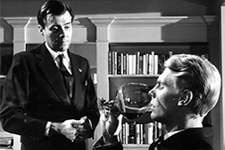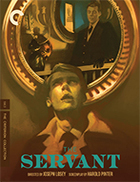The Servant
|  The Servant was the first of three collaborations between American expatriate director Joseph Losey and playwright/screenwriter Harold Pinter—which Losey described to Michel Ciment as “the best and most useful collaboration I’ve ever had”—and the second of his five collaborations with actor Dirk Bogarde. It was a major turning point for Losey’s career, as it followed the release of Eve (1962), a film that Losey said was “as close to being a great film as I had ever achieved” before it was taken away from him and radically recut, losing some 40 minutes of footage and greatly altering his vision. Such misfortune did not befall The Servant, which remains the dark, pessimistic, and morbidly engaging story Losey and Pinter intended it to be. Based on the 1948 novella by Robin Maugham, The Servant centers on the complex, mutually destructive relationship between Tony (James Fox), an idle, wealthy young heir and his manservant, Barrett (Dirk Bogarde). Tony is arrogant, lazy, and entitled, which is why he needs someone like Barrett to tend to his needs and whims. When we first meet the characters, Barrett is meeting Tony for an employment interview in an empty, dilapidated Chelsea townhouse that Tony plans to renovate. The townhouse proves to be a crucial component of the film’s drama, not just because so much of the action unfolds within its walls, but because it comes to stand as a kind of indicator of Tony’s state and his increasing dependence on Barrett. When Barrett, who is put in charge of decorating the townhouse and therefore impresses upon it his own sensibility, is not there, it falls into disarray. When he is there, it is kept tidy and organized. And when the power balance between the two men shifts, the townhouse becomes a psychological war zone that bears many, many scars. And that primarily is what The Servant is. Despite the title and the early suggestion that the film will simply be a dramatization of the manner in which the aristocracy exploits the underclass for servitude, it is actually a twisted, dark, and wildly unpredictable psychodrama in which power fluctuates between Tony and Barrett. Calling it “class warfare” would be overly reductionist since their economic and social standing is just one component (albeit a very important one) of their complicated relationship, although part of the film’s sadistic pleasure is seeing Barrett wresting control away from Tony and turning the tables on him, forcing him into a state of near infantilism. Yet, as much as Tony is an insufferable product of extreme privilege and wealth that he has done nothing to earn, we can’t help but feel for his predicament and wince at his various humiliations, especially when Barrett convinces him to allow his supposed sister, Vera (Sarah Miles), to live in the house with them. When he directed The Servant, Joseph Losey had been living in exile in Europe for the better part of a decade after being blacklisted in Hollywood for his ties to leftwing artists, including playwright Bertolt Brecht, with whom he had worked in the theatre in the 1940s. He had directed a number of films in Hollywood, including his debut, the allegorical The Boy With Green Hair (1947) and a 1951 remake of Fritz Lang’s M. After moving to Europe, he found steady work as a director, making a film almost every year, although sometimes under pseudonyms. Nevertheless, Losey’s style was always apparent, especially his penchant for intense camera movements and ornate, stylized settings, all of which characterize The Servant, which is arguably one of the best examples of how effectively he externalized his characters’ psychology onto the world around them. Losey makes frequently amazing use of stairwells, doorways, and mirrors, not to mention light and shadow (the cinematographer, Douglas Slocombe, was a 20-year veteran who had worked with Alexander Mckendrick and John Huston and would go on to work with Ken Russell and Steven Spielberg). Pinter’s biting dialogue gains additional sting in Losey’s compositions, which slowly turn the film into an escalating nightmare of depravity. James Fox, who was early in his career and largely unknown at the time, portrays Tony as a fundamentally weak man who has become so accustomed to others serving him that he has literally no sense of how to manage himself when Barrett unleashes on him. Which, of course, brings us to Barrett. Dirk Bogarde, who was in the midst of a major career transformation from young, matinee idol leading man to middle-aged character actor, plays him as a cunning viper, well-seasoned in the manners and norms of the serving class, but always coiled and waiting to strike. Tony’s girlfriend, Susan (Wendy Craig), intuits Barrett’s darker impulses and tries to stand between him and Tony, but it is futile. Barrett embodies all the repressed anger of the underclass toward the ruling class, and his vengeance is so cold and ruthless that it burns away any potential pleasure in upending the system. It turns out the cruelty is just as ugly coming from the bottom as it is from the top.
Copyright © 2023 James Kendrick Thoughts? E-mail James Kendrick All images copyright © The Criterion Collection | |||||||||||||||||||||||||||||
Overall Rating: 

 (3)
(3)


